
Hyacinthoides non-scripta is a bulbous perennial plant, found in Atlantic areas from north-western Spain to the British Isles, and also frequently used as a garden plant. It is known in English as the common bluebell or simply bluebell, a name which is used in Scotland to refer to the harebell, Campanula rotundifolia. In spring, H. non-scripta produces a nodding, one-sided inflorescence of 5–12 tubular, sweet-scented violet–blue flowers, with strongly recurved tepals, and 3–6 long, linear, basal leaves.
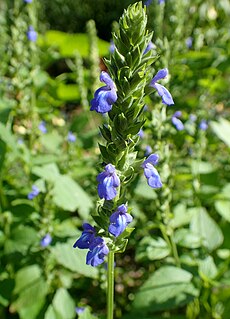
Salvia hispanica, commonly known as chia, is a species of flowering plant in the mint family, Lamiaceae, native to central and southern Mexico and Guatemala. It is considered a pseudocereal, cultivated for its edible, hydrophilic chia seed, grown and commonly used as food in several countries of western South America, western Mexico, and the southwestern United States.
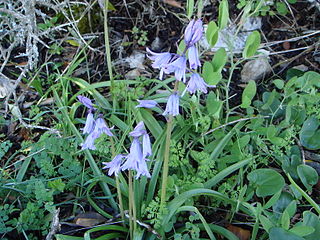
Hyacinthoides hispanica, the Spanish bluebell, is a spring-flowering bulbous perennial native to the Iberian Peninsula. It is one of around a dozen species in the genus Hyacinthoides, others including the common bluebell in northwestern Europe, and the Italian bluebell further east in the Mediterranean region.

Hyacinthoides is a genus of flowering plants in the family Asparagaceae, known as bluebells.

Pierre Edmond Boissier was a Swiss prominent botanist, explorer and mathematician. He was the son of Jacques Boissier (1784-1857) and Caroline Butini (1786-1836), daughter of Pierre Butini (1759-1838) a well-known physician and naturalist from Geneva. With his sister, Valérie Boissier (1813-1894), he received a strict education with lessons delivered in Italian and Latin. Edmond's interest in natural history stemmed from holidays in the company of his mother and his grandfather, Pierre Butini at Valeyres-sous-Rances. His hikes in the Jura and the Alps laid the foundation of his zest for later exploration and adventure. He attended a course at the Academy of Geneva given by Augustin Pyramus de Candolle.
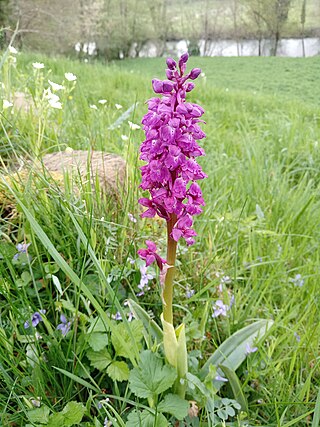
Orchis mascula, the early-purple orchid, early spring orchis, is a species of flowering plant in the orchid family, Orchidaceae.

Francisco Ibáñez de Segovia y Peralta (1644–1712) was a Spanish colonial administrator who was Royal Governor of Chile from 1700 to 1709. He was born in Madrid and died in Lima.
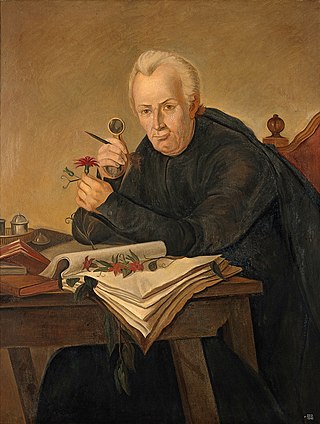
José Celestino Bruno Mutis y Bosio was a Spanish priest, botanist and mathematician. He was a significant figure in the Spanish American Enlightenment, whom Alexander von Humboldt met with on his expedition to Spanish America. He is one of the most important authors of the Spanish Universalist School of the 18th century, together with Juan Andrés or Antonio Eximeno.

Sphincterochila cariosula is a species of air-breathing land snail, a terrestrial pulmonate gastropod mollusk in the family Sphincterochilidae.

Tomás Antonio Álvarez de Acevedo Ordaz was a Spanish colonial administrator who twice served as interim Royal Governor of Chile, first in 1780 and again between 1787 and 1788.

Nuevo Baztán is a municipality southeast of Madrid, near Alcalá de Henares, Spain. It consists of a small historic centre and modern housing estates.

Hispidella is a genus of flowering plants in the family Asteraceae. The genus is monotypic with only one known species, Hispidella hispanica, native to the Iberian Peninsula.

The La Pedrera de Rúbies Formation is an Early Cretaceous (late Berriasian to early Barremian geologic formation in Catalonia, Spain. The formation crops out in the area of the Montsec in the Organyà Basin. At the La Pedrera de Meià locality, the formation consists of rhythmically laminated, lithographic limestones that formed in the distal areas of a large, shallow coastal lake. It is noted for the exceptional preservation of articulated small vertebrates and insects, similar to that of the Solnhofen Limestone.
Eduardo Paniagua is a Spanish architect and musician, specializing in medieval Spanish music.
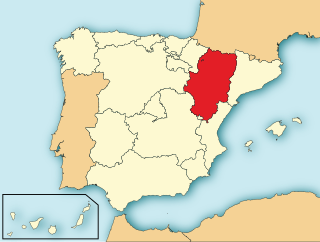
Psilocybe hispanica is a species of fungus in the family Hymenogastraceae. It produces small brown mushrooms with conical to convex caps up to 10 mm (0.4 in) in diameter and stems 16 to 25 mm long by 0.5 to 1 mm thick. Reported as new to science in 2000, it is only known from the Pyrenees mountain range in northern Spain and southwestern France, where it grows on horse dung in grass fields at elevations of 1,700 to 2,300 m. The mushroom contains the psychoactive compound psilocybin. The possible depiction of this species in the 6,000-year-old Selva Pascuala rock art suggests that it might have been used in ancient religious rituals—the oldest evidence of such usage in prehistoric Europe.

The Guayadeque ravine, in Spanish Barranco de Guayadeque, is a ravine-type valley located on the Spanish municipalities of Ingenio and Agüimes, in the province of Las Palmas on Grand Canary island, off the coast of Morocco.

Ambrosia peruviana is a species of plant in the family Asteraceae. It occurs from Mexico south to Argentina, being common in the Antilles and the Andes.
Famara is the main mountainous massif in the north of the island of Lanzarote in the Canary Islands. It is the eastern slope of a volcano erupting in the Miocene. The cliffs of Famara are the remains of a caldera of about ten kilometres in diameter centred on the south of La Graciosa.

Genista hispanica, the Spanish gorse, or anlaga, is a species of flowering plant in the family Fabaceae, native to southern France and northern Spain. It is suited for borders, wall and rock gardens, gravelly soils, and coastal situations.

Nigella hispanica, the Spanish fennel flower, is a species of flowering plant in the family Ranunculaceae, native to Portugal, Spain, and France. An annual or biennial reaching 60 cm (2 ft), the Royal Horticultural Society considers it a good plant to attract pollinators.
















